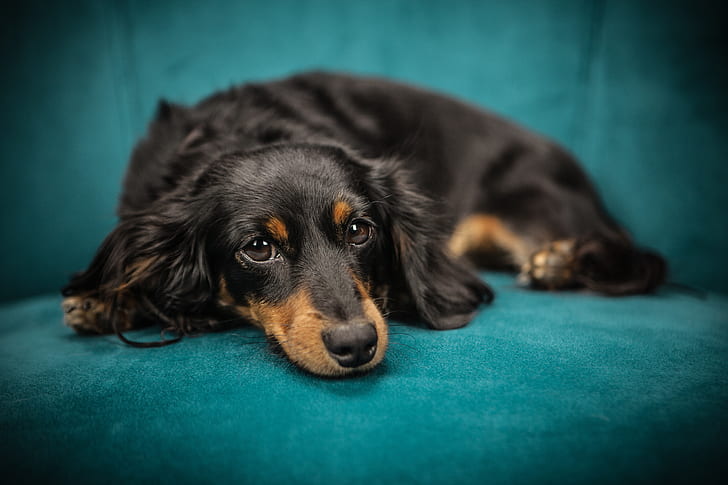Do you want to learn how to identify a purebred Dachshund? You are in the right place.
Dachshunds are charming dogs with elongated bodies and small legs. Many people like these dogs because of their unique appearance and loyalty.
Despite their small size, they make excellent watchdogs. They are naturally suspicious of strangers. They will not hesitate to alert their owners when they see unfamiliar people or hear sounds.
Dachshunds have a playful nature and enjoy engaging in games and activities. This makes them a joy to be around, and their curiosity keeps life interesting for their owners.
Before owning a Dachshund, knowing if it is purebred is important. This is why I created this post to help you.
Let us get right into it.
How To Identify If A Dachshund Is Purebred
Here are 10 ways:
1) Pedigree Papers
Pedigree papers are the most reliable method of confirming that your Dachshund is purebred. These documents record the dog’s lineage and should be provided by a reputable breeder. A lineage chart will trace the genealogy of your pet through multiple generations and confirm the absence of any cross-breeding. These documents function much like a birth certificate for your dog
2) Standard Body Proportions
Purebred Dachshunds have long bodies and short legs. The unique shape allows them to burrow into holes in search of prey. If your Dachshund possesses these proportions, it is likely to be purebred.
3) Distinctive Facial Features
A purebred Dachshund has an elongted snout and long ears that hang down close to the head. The length of the snout often reflects the breed’s historical role as a hunting dog, allowing for a strong sense of smell. When the dog is attentive, the top of the ear should align almost perfectly with the eye line, giving the breed its attentive expression.
4) Weight and Size
Purebred Dachshunds come in three sizes: standard, miniature, and kaninchen (rabbit-sized). The standard size Dachshunds usually weigh between 16 to 32 pounds. The miniature version weighs under 12 pounds. Knowing the weight and size of your Dachshund will provide clues to its pedigree.
5) Dental Structure
Purebred Dachshunds have a scissor bite, where the upper teeth neatly overlap the lower teeth. Deviations from this dental structure might indicate mixed ancestry.
6) Eye Color and Shape
Purebred Dachshunds have dark almond-shaped eyes. The eyes should be set well apart and give an alert, intelligent appearance.
7) Movement and Gait
A purebred Dachshund displays a fluid and smooth movement resulting from the proportionate body and structure. The motions should appear effortless, without any sense of awkwardness or imbalance. The back should remain relatively flat, without noticeable arching or dipping, which could indicate skeletal issues or non-standard anatomy.
8) Coat Colors and Patterns
The Dachshund breed has a diverse range of coat types and patterns, making it crucial to understand these variations.
Smooth Coat – Some purebred Dachshunds have a smooth coat that is short and glossy. The sheen on their coats is a good indicator of their general health and well-being.
Wirehaired Coat – Wirehaired Dachshunds feature a distinctive two-layer coat. The outer layer is coarse and rough, providing a protective barrier, while the undercoat is finer and softer, serving as insulation. This variety is particularly resilient and suited for outdoor activities.
Longhaired Coat – These Dachshunds have luxurious, shiny coats. This coat type requires regular grooming to maintain its sleek appearance.
Here are the common coat patterns:
Solid Coats – They range from shades of red to black, chocolate, and even cream.
Dapple or Merle Coats – Darker base color with spots or patches of lighter shades. This pattern adds a unique texture and depth to the coat’s appearance.
Brindle Coats – Brindle Dachshunds have a striped pattern consisting of darker stripes set against a lighter base color.
Piebald Coats – Piebald Dachshunds have coats that are either monochromatic or bi-colored but feature distinct white patches.
Sable Coats – Sable Dachshunds have a singular coat pattern with a red base covered with a darker overlay.
9) Tail
The tail of a purebred Dachshund is elongated, following the line of the spine. It should be slightly curved but not excessively so. The tail acts as a rudder when the Dachshund is digging or maneuvering underground. This is why it is an important feature for identification.
10) Genetic Testing
Genetic testing will provide definitive answers if you are still uncertain about your Dachshund’s purity after considering all these traits. DNA tests designed for dogs will help you identify the lineage and confirm if your Dachshund is purebred.
Conclusion
By now, you should know if your Dachshund is purebred. Knowing what to look for gives you more confidence in assessing its lineage.
Purebred Dachshunds tend to have an alert yet playful expression. This reflects their curious and brave personalities.
I recommend searching for pedigree papers or genetic testing if you are still unsure. These are the most reliable methods to determine if your Dachshund is purebred.

